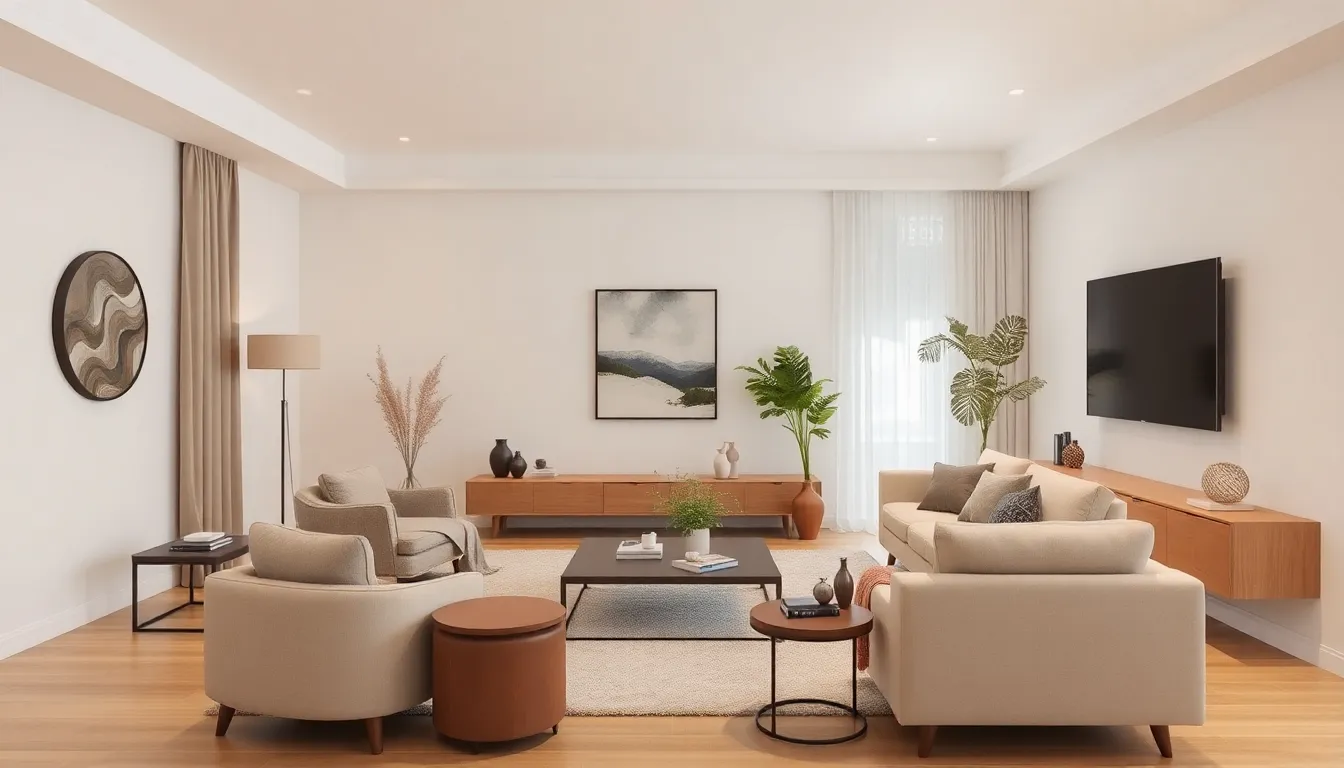The living room is where magic happens, from cozy movie nights to lively gatherings with friends. It’s not just a space; it’s the heart of the home, a canvas waiting for a splash of creativity. But let’s face it: a bland living room can suck the life out of even the most enthusiastic hosts. Who wants to entertain in a space that feels more like a waiting room than a welcoming retreat?
Table of Contents
ToggleKey Elements of Living Room Design Decor
Effective living room design decor hinges on several key elements that together create an inviting and functional space. Attention to detail in areas such as color schemes, furniture selection, and lighting can transform this central hub of the home.
Color Schemes
Color schemes play a crucial role in setting the mood of the living room. Warm tones like reds and oranges create a cozy atmosphere, while cool tones, such as blues and greens, promote relaxation. Combine neutral tones with bold accent colors to achieve a balanced look. For instance, a beige sofa pairs well with vibrant throw pillows. Select colors that reflect personal style and support the overall theme of the room.
Furniture Selection
Furniture selection impacts both comfort and functionality in the living room. Prioritize pieces that reflect the size of the space. Large sectional sofas offer ample seating, while smaller chairs can create a cozy nook. Choose versatile furniture that serves multiple purposes, such as ottomans with storage capabilities. Ensure styles blend harmoniously, coordinating modern and traditional elements for a cohesive aesthetic.
Lighting Considerations
Lighting considerations elevate the living room’s ambiance and functionality. Incorporate a mix of ambient, task, and accent lighting. Ceiling fixtures provide overall illumination, while table lamps serve specific activities like reading. Include dimmer switches to adjust lighting levels for different occasions. Natural light also enhances the space; utilize sheer curtains to allow sunlight while maintaining privacy.
Popular Living Room Design Styles

Various living room design styles create unique atmospheres and cater to different preferences. Here are three popular styles that define contemporary decor.
Modern and Minimalist
Modern and minimalist styles emphasize simplicity and functionality. Clean lines characterize furniture with a focus on neutral colors. Often, these spaces use a limited color palette, relying on various textures to add visual interest. Minimal art pieces or decor enhance the ambiance without overwhelming the senses. Natural light plays a significant role, providing warmth and openness, making the space feel larger and more inviting.
Rustic and Cozy
Rustic and cozy designs create a warm, inviting environment. Wood accents, stone elements, and natural fabrics evoke a sense of comfort and nostalgia. Earthy tones, such as browns and greens, dominate color schemes, enhancing the connection to nature. Furnishings often include plush sofas and oversized chairs, encouraging relaxation. Accessories like throw blankets and handmade items add personal touches that make the space feel lived-in and welcoming.
Transitional Design
Transitional design beautifully blends traditional and contemporary elements. This style balances classic furniture shapes with modern fabrics and finishes. Neutral color schemes, accented by bold colors, provide visual interest while maintaining a cohesive look. Lighting fixtures often incorporate both vintage and modern designs, adding an eclectic feel. Versatile furniture pieces maximize comfort and functionality, allowing for easy adaptations to suit guests’ needs or occasions.
Decorative Accessories for Living Rooms
Decorative accessories enhance a living room’s aesthetic appeal while creating a personalized atmosphere. Incorporating specific elements significantly elevates the room’s design.
Artwork and Wall Decor
Art pieces contribute to the visual storytelling of a living room. Large canvases or framed prints draw attention, facilitating conversation among guests. Sculptures add dimension and intrigue, while wall decals can provide playful flair. Recommendations include selecting artworks that resonate personally or reflect the home’s color scheme. Gallery walls combine various sizes and styles for a curated look.
Textiles and Soft Furnishings
Soft furnishings introduce comfort and warmth into a living room. Cushions with various textures invite relaxation, while throws add color and layers. Rugs define spaces, offering warmth underfoot and anchoring furniture arrangements. Opting for fabrics that complement the overall color palette enhances a cohesive look. Consider mixing patterns for an engaging visual experience, ensuring harmony in the design.
Decorative Accents and Accessories
Accessorizing with decorative pieces adds unique character to the space. Vases filled with fresh flowers bring organic beauty, while candles create a warm ambiance. Unique trinkets and books add personal touches that spark conversations. Incorporate trays to organize items while maintaining a tidy appearance. Prioritizing diversity in shapes and materials ensures a dynamic, visually interesting living room.
Tips for Personalizing Your Living Room
Personalizing a living room enhances its character and reflects individual tastes. Unique touches create a space that’s truly one’s own.
Incorporating Family Heirlooms
Incorporating family heirlooms adds sentimental value and connects the living room to personal history. Items such as antique furniture, vintage photographs, and cherished trinkets contribute to a unique narrative. Placement of these pieces can create focal points, sparking conversations among guests. Displaying them alongside modern decor creates an interesting contrast that enhances the overall aesthetic. Consider using dedicated shelving or dedicated wall spaces to showcase these treasures.
Utilizing Personal Artwork
Utilizing personal artwork showcases creativity and establishes a personal connection within the living room. Original paintings, photographs, or crafts can serve as conversation starters and enhance the space’s warmth. Arranging artwork in a gallery style offers visual interest while celebrating individual expression. Changing art displays periodically keeps the living room fresh and engaging. Choosing a color palette that complements other elements also ensures harmony in the overall design.
Creating a Thematic Space
Creating a thematic space allows for cohesive design that reflects specific interests or passions. Themes, such as coastal, bohemian, or mid-century modern, unify decor elements and enhance the room’s ambiance. Selecting a color scheme, furniture, and accessories that align with a chosen theme strengthens overall coherence. Accessories like cushions, rugs, and decorative items can reinforce this theme. Familiar elements give the room a distinctive identity, making it feel more inviting and personalized.
A well-designed living room is more than just a space; it’s the heart of the home. By thoughtfully selecting colors furniture and lighting, anyone can create an inviting atmosphere that encourages connection and relaxation. The incorporation of personal touches and decorative accessories adds character and warmth making the space truly unique.
Choosing a design style that resonates with individual preferences enhances the overall experience. Whether embracing modern minimalism or rustic charm each element contributes to a cohesive and welcoming environment. Ultimately a beautifully curated living room not only elevates the home but also enriches the lives of those who gather within it.






